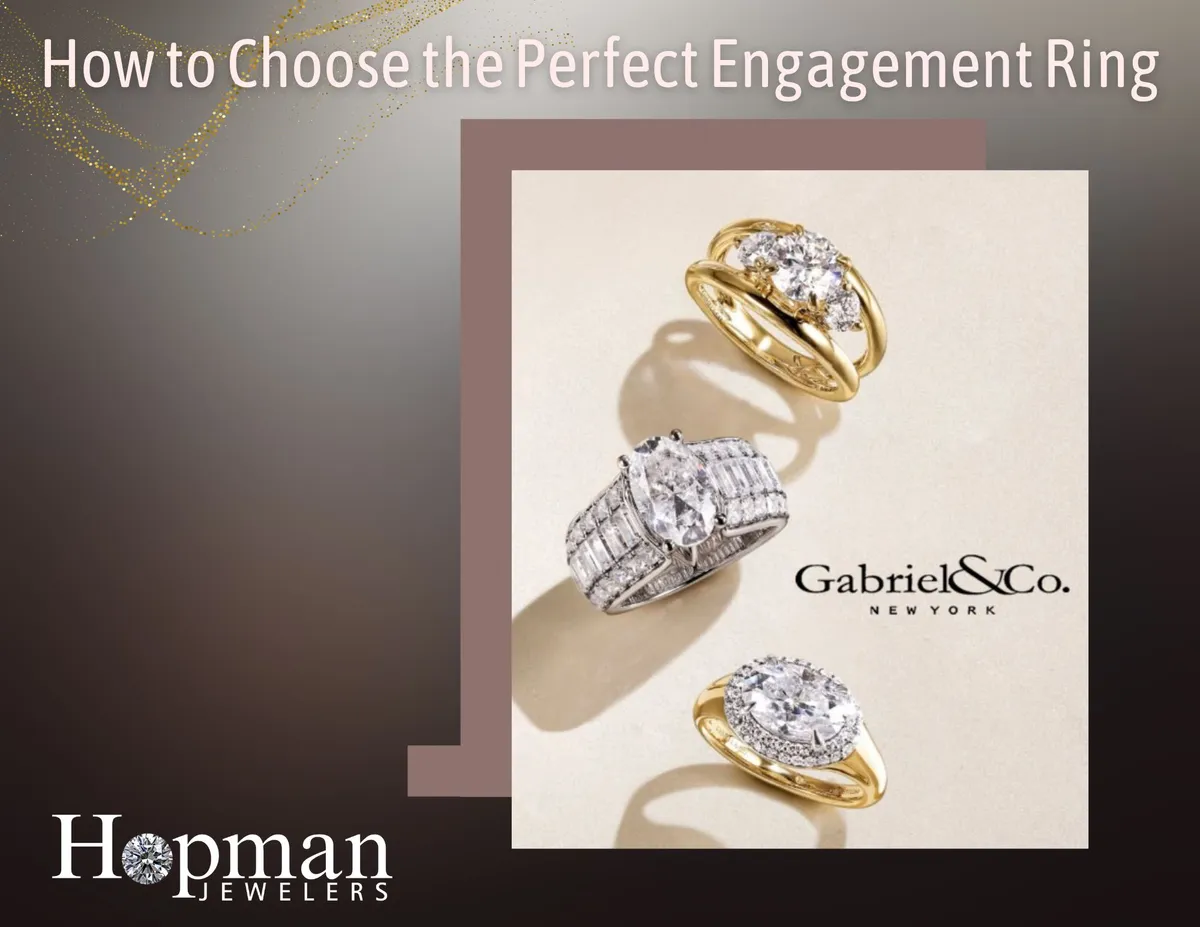Engagement Rings
How to Choose the Perfect Engagement Ring: A Step-by-Step Guide
Published: Jul 28, 2025

How to Choose the Perfect Engagement Ring: A Step-by-Step Guide
Choosing an engagement ring is a milestone moment, one that symbolizes love, commitment, and the beginning of forever. With so many choices available, the process can feel overwhelming. That’s why we’ve created this step-by-step guide to help you navigate the key factors: from diamond shapes and settings to metal types and personalization.
Whether you’re shopping solo or ring hunting together, this guide will help you find a ring as timeless and unique as your love story.
Step 1: Understand Diamond Shapes
The shape of the diamond is one of the most defining features of any engagement ring. It affects the overall style and personality of the piece.
Popular Diamond Shapes:
Step 2: Choose the Right Setting
The setting holds the diamond in place and greatly affects the ring’s overall appearance and security.
Popular Engagement Ring Settings:
Step 3: Select the Metal Type
The metal color not only affects the look of the ring but also how it complements your partner’s skin tone and other jewelry.
Common Engagement Ring Metals:
Step 4: Know the 4Cs of Diamonds
When selecting your diamond, it's important to consider the 4Cs, the globally accepted standards used to assess a diamond's quality:
Cut: Impacts how sparkly a diamond is. A well-cut diamond reflects light beautifully.
Color: Measures how colorless a diamond is. The scale runs from D (colorless) to Z (light yellow).
Clarity: Refers to internal and external imperfections. The fewer inclusions, the better the clarity.
Carat Weight: Indicates the size of the diamond, but remember, size isn’t everything!
Tip: A smaller diamond with excellent cut and clarity can often outshine a larger, lower-quality stone. Prioritize cut, it has the most impact on brilliance. If you're on a budget, consider lowering the color and clarity slightly, but never compromise too much on cut. Also, some shapes (like oval and marquise) tend to look larger than round diamonds of the same carat weight, great for maximizing your budget! Ask your jeweler to show diamonds side-by-side so you can visually compare sparkle, clarity, and size.
Step 5: Make It Personal
At Hopman Jewelers, we believe every love story is unique and your ring should be too. Consider these personal touches:
Step 6: Shop with Confidence
When you're ready to shop, choose a jeweler you trust. At Hopman Jewelers in Downtown Elkhart, we’ve been helping couples find their forever rings since 1960. From Gabriel & Co. engagement rings to custom designs and lab-grown options, we’ll help you find the perfect ring or create one from scratch. Stop in to browse, ask questions, or schedule a free engagement ring consultation.
Tip: Look for jewelers with great reviews, proper certifications (like GIA-trained staff), and a reputation for honesty and quality service. Ask about warranties, upgrade policies, and care instructions, this is a lifetime purchase, and you want a jeweler who stands behind their work.
Ready to find the ring?
Visit us at Hopman Jewelers, where love meets craftsmanship.
Choosing an engagement ring is a milestone moment, one that symbolizes love, commitment, and the beginning of forever. With so many choices available, the process can feel overwhelming. That’s why we’ve created this step-by-step guide to help you navigate the key factors: from diamond shapes and settings to metal types and personalization.
Whether you’re shopping solo or ring hunting together, this guide will help you find a ring as timeless and unique as your love story.
Step 1: Understand Diamond Shapes
The shape of the diamond is one of the most defining features of any engagement ring. It affects the overall style and personality of the piece.
Popular Diamond Shapes:
- Round Brilliant: Classic and timeless. Offers the most sparkle due to its faceting.
- Princess Cut: Square-shaped and modern with great brilliance.
- Oval: Elegant and elongating on the finger; a great blend of classic and unique.
- Emerald Cut: Step-cut with long, clean lines, sophisticated and vintage-inspired.
- Cushion Cut: Soft, rounded edges; romantic and elegant.
- Pear-Shaped: A teardrop shape that is both feminine and distinctive.
- Marquise: Long and narrow, this shape maximizes perceived size.
Step 2: Choose the Right Setting
The setting holds the diamond in place and greatly affects the ring’s overall appearance and security.
Popular Engagement Ring Settings:
- Solitaire: A single diamond on a plain band. Timeless, elegant, and perfect for showcasing a stunning center stone.
- Halo: A center diamond surrounded by smaller diamonds-adds sparkle and makes the center stone appear larger.
- Three-Stone: Symbolizes your past, present, and future. Often features a larger center stone with two smaller side stones.
- Pavé: The band is covered with tiny diamonds, giving the ring a glittering look from every angle.
- Bezel: The diamond is completely or partially surrounded by metal, sleek, modern, and very secure.
- Vintage-Inspired: Intricate details like milgrain or filigree give these rings old-world charm.
Step 3: Select the Metal Type
The metal color not only affects the look of the ring but also how it complements your partner’s skin tone and other jewelry.
Common Engagement Ring Metals:
- Yellow Gold: A traditional favorite that offers a warm, classic glow.
- White Gold: A sleek, modern look that pairs beautifully with diamonds.
- Rose Gold: Romantic and trendy, with a soft pink hue.
- Platinum: Naturally white, hypoallergenic, and extremely durable, perfect for heirloom-quality rings.
- Cool undertones: white gold or platinum
- Warm undertones: yellow or rose gold
- Neutral tones: any metal works beautifully
Step 4: Know the 4Cs of Diamonds
When selecting your diamond, it's important to consider the 4Cs, the globally accepted standards used to assess a diamond's quality:
Cut: Impacts how sparkly a diamond is. A well-cut diamond reflects light beautifully.
Color: Measures how colorless a diamond is. The scale runs from D (colorless) to Z (light yellow).
Clarity: Refers to internal and external imperfections. The fewer inclusions, the better the clarity.
Carat Weight: Indicates the size of the diamond, but remember, size isn’t everything!
Tip: A smaller diamond with excellent cut and clarity can often outshine a larger, lower-quality stone. Prioritize cut, it has the most impact on brilliance. If you're on a budget, consider lowering the color and clarity slightly, but never compromise too much on cut. Also, some shapes (like oval and marquise) tend to look larger than round diamonds of the same carat weight, great for maximizing your budget! Ask your jeweler to show diamonds side-by-side so you can visually compare sparkle, clarity, and size.
Step 5: Make It Personal
At Hopman Jewelers, we believe every love story is unique and your ring should be too. Consider these personal touches:
- Custom Design: Work with our team to create a one-of-a-kind ring from sketch to sparkle.
- Hidden Details: Add a special engraving or hidden diamond under the setting.
- Stackable Wedding Band Compatibility: Think ahead to how the ring will pair with a future wedding band.
Step 6: Shop with Confidence
When you're ready to shop, choose a jeweler you trust. At Hopman Jewelers in Downtown Elkhart, we’ve been helping couples find their forever rings since 1960. From Gabriel & Co. engagement rings to custom designs and lab-grown options, we’ll help you find the perfect ring or create one from scratch. Stop in to browse, ask questions, or schedule a free engagement ring consultation.
Tip: Look for jewelers with great reviews, proper certifications (like GIA-trained staff), and a reputation for honesty and quality service. Ask about warranties, upgrade policies, and care instructions, this is a lifetime purchase, and you want a jeweler who stands behind their work.
Ready to find the ring?
Visit us at Hopman Jewelers, where love meets craftsmanship.
